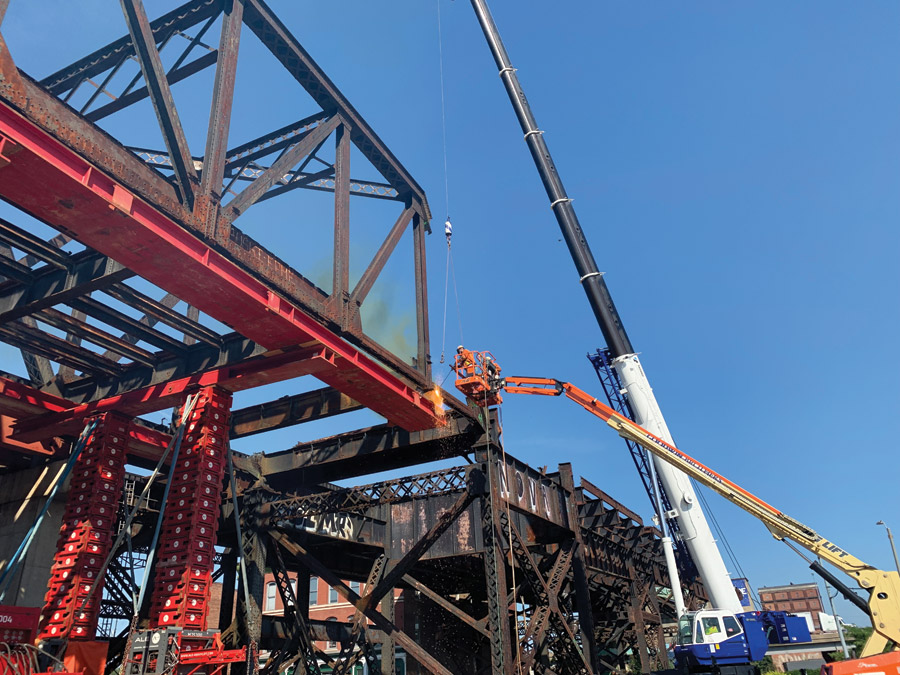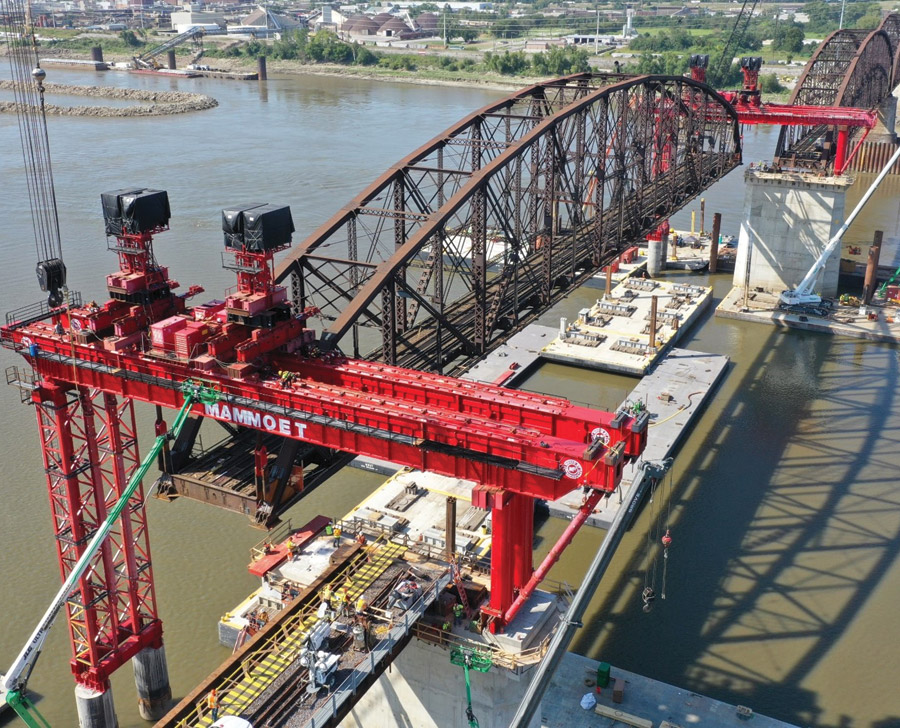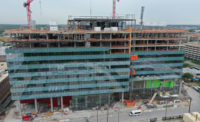In existence since 1889 and for about 100 years previously under another name, the Terminal Railroad Association of St. Louis (TRRA) owns 50 miles of mainline railroad track, a major classification yard and other outlying yards, two Mississippi River bridges, riverfront ports and other facilities that function as an economic driver for the Missouri and Illinois regions.
TRRA works to ensure that freight and passenger trains continue to move smoothly through the St. Louis terminal.
In recognition of its support of commerce over the Mississippi and for meeting the demands of financing and reconstructing aging bridges to meet contemporary railroad needs, ENR Midwest has named TRRA as its 2024 Owner of the Year.
TRRA Takes on Two Bridges
Even before construction was complete on the Merchants Bridge, the older of the two bridges, TRRA began work on the MacArthur Bridge, an ongoing project that has already resulted in the replacement of a single span truss with a three-span girder bridge, demolition of the abandoned roadway bridges and installation of a retaining wall.
The $222-million replacement of the Merchants Bridge, which serves five Class 1 railroads and Amtrak, was completed in 2022. The original bridge dated to 1890 and was designed by George Morrison, who designed some of the first large-scale steel truss bridges in the country.
As years rolled by and the Merchants Bridge and the MacArthur Bridge, which opened in 1917, continued to age, TRRA faced a decision.
“The question was major rehabilitation of the bridges or obsolescence. The ultimate decision was major rehab—in fact, replacement,” says Eric Fields, chief engineer for TRRA.
Increasing Rail Capacity
The replacement Merchants Bridge, which earned a Best Project award in ENR Midwest’s highway/bridge category in 2023, will increase rail bridge capacity to help meet the anticipated increased demand in rail tonnage of over 49% and boost economic activity by $456 million over the next 20 years, TRRA projects.
“The question was major rehabilitation of the bridges or obsolescence. The ultimate decision was major rehab, in fact, replacement.”
—Eric Fields, Chief Engineer, TRRA
Work on the Merchants Bridge entailed replacement of three 520-ft-long double-track truss spans and seismically retrofitting and encasing the existing masonry river piers. The east and west approach structures were improved by adding ballasted deck to 940 ft of existing deck plate girder approach spans and encasing an existing 750-ft steel trestle in lightweight concrete fill with mechanically stabilized earth walls.
Fields says encasing a trestle to improve its clearances and load capacity in an area known for seismic volatility, all while keeping trains running, is a model for other Mississippi River bridges with similar challenges.
“Some of the techniques used on the Merchants Bridge will be transferred to other bridges,” he says. “If you encase a trestle and put in some foundation elements to strengthen it, you can do all that work below track so you won’t impact traffic or customers. You can get those trestles up to a good load rating and do it relatively inexpensively.”
The replacement of the Merchants Bridge was completed on time, thanks to coordination by TRRA, says Dan Sieve, senior project manager at Walsh Construction.
“During our design and planning for replacing the Merchants Bridge, TRRA enabled teamwork by inviting us to work with their engineers [and] safety and operations staff to find solutions that were feasible while we were dealing with a 130-year-old structure and an operating railroad,” Sieve says. “The results of this communicative process enabled us to compete the replacement of the span in 30% less time than they had anticipated.”
Kevin Eisenbeis, national bridge practice leader for Burns & McDonnell, which was structural design leader on the Merchants Bridge, agrees that working with TRRA was collaborative.
“As the owner, TRRA provided oversight and direction for the project, yet were very receptive to ideas presented by the design team,” Eisenbeis says. “The design considered a variety of span layouts, pier locations and potential construction schemes in the early stages of design. The TRRA team played an integral role in getting to the final design solution.”
Brent Wood, president and CFO of the railroad association, says Fields oversaw the construction projects overall while an engineer was assigned to handle day-to-day operations with contractors.
“That helped the relationship with Walsh and other contractors because if they needed anything they knew where to go to get action,” Wood says. “We had a lot of disruptions to their process when we needed trains to clear the bridge and vice versa, when they needed track time. We needed to plan ahead for that. I think our role was to be a quarterback.”
Walsh and other contractors were given one track on the Merchants Bridge to work on so that trains could continue to run, and they did much of the work under the bridge. At its peak, there were between 100 and 200 people working on the structure.
Sieve says the project’s greatest construction challenge was replacing three bridge spans.
“Even though each replacement occurred several months apart, the work required a collaboration of many entities including all of the rail companies serviced by TRRA, the U.S. Coast Guard and the U.S. Army Corps of Engineers,” he says.
The new spans were constructed by Veritas Steel in Eau Claire, Wis., and shipped to St. Louis for final assembly.

The existing truss is demolished on the MacArthur Bridge.
Photo courtesy of TranSystems
Preparing for Evolving Needs
The second phase of the $15-million rehabilitation of the MacArthur Bridge, which stands just south of the Merchants Bridge, will rehabilitate the main spans and the east approach. It is slated for completion in 2026.
“The MacArthur Bridge is a second-generation truss span over the Mississippi River. The trusses are designed with nickel steel that is more corrosion resistant than the Merchants Bridge, but not all of its elements were,” Fields says. “The floor system, which sits under the track, is what we are focused on [in Phase 1] because it was made of regular steel at the time and had a shorter service life.”
Both projects are intended to meet the evolving needs of railroads.
“The trend in rail today is to not let the infrastructure be a limiting constraint and to build the infrastructure to handle heavier and wider railroad cars,” Fields says.
The new bridges are able to support railroad cars weighing up to 315,000 lb versus the current standard of 286,000 lb. They can also handle car widths of 15 ft versus their previous limit of about 13.5 ft.
Losing one of the bridges would have adversely affected economic growth.
“We need more rail capacity to handle the nation’s growth, and the loss of one of these Mississippi River bridges would be a problem for congestion in other networks, even into Chicago,” Fields says. “There is a lot of overflow from Chicago into the St. Louis area when cargo [in Chicago] gets backed up. Having these river bridges is a huge asset to the whole network.”

Walsh Construction lifts the east span of the Merchants Bridge using a gantry system.
Photo courtesy of The Terminal Railroad Association of St. Louis
Addressing Financing Hurdles
For both bridges, an even greater challenge was putting together the financing of the projects. TRRA’s process included developing an asset management plan for long-term funding, projections of the impact of the proposed improvements on the economy and getting the plan approved by five Class 1 railroads that fund the association’s operations through tariffs for using its bridges and other infrastructure.
Wood credits Fields with crafting an accurate budget for the Merchants Bridge replacement.
“There is a lot of history here. It didn't seem like big stretch to at least preserve some of it."
—Brent Wood, President & CFO, TRRA
“We got the project budget done in 2016, and when we got the project completed, [the budget] held true. We actually came in under budget, which is unusual when you are talking seven to eight years to completion,” Wood says.
While replacing the bridges was a large task, Fields says coordinating with the many different entities involved was an even larger accomplishment.
“To get five Class 1 railroads to join together on a topic of [replacing] a major asset was an achievement,” he says.
Looking forward, Fields predicts the Merchants Bridge will last well over 100 years.
Remembering the Past
While the future for moving freight over the Mississippi in St. Louis looks bright, TRRA has not forgotten the past. It saved a medallion from the original bridge that it donated to the National Transportation Museum in St. Louis. It also coordinated with Walsh to save some scrap metal that it is donating to artists to make sculptures or other artwork from it.
“There is a lot of history here,” Wood says. “It didn’t seem like a big stretch to at least preserve some of it.”





